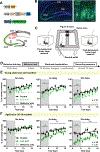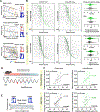Localized APP expression results in progressive network dysfunction by disorganizing spike timing
- PMID: 37909036
- PMCID: PMC10877582
- DOI: 10.1016/j.neuron.2023.10.001
Localized APP expression results in progressive network dysfunction by disorganizing spike timing
Abstract
Progressive cognitive decline in Alzheimer's disease could either be caused by a spreading molecular pathology or by an initially focal pathology that causes aberrant neuronal activity in a larger network. To distinguish between these possibilities, we generated a mouse model with expression of mutant human amyloid precursor protein (APP) in only hippocampal CA3 cells. We found that performance in a hippocampus-dependent memory task was impaired in young adult and aged mutant mice. In both age groups, we then recorded from the CA1 region, which receives inputs from APP-expressing CA3 cells. We observed that theta oscillation frequency in CA1 was reduced along with disrupted relative timing of principal cells. Highly localized pathology limited to the presynaptic CA3 cells is thus sufficient to cause aberrant firing patterns in postsynaptic neuronal networks, which indicates that disease progression is not only from spreading pathology but also mediated by progressively advancing physiological dysfunction.
Keywords: Alzheimer’s disease; amyloid precursor protein; hippocampus; phase precession; spike timing; theta oscillations.
Copyright © 2023 The Author(s). Published by Elsevier Inc. All rights reserved.
Conflict of interest statement
Declaration of interests The authors declare no competing interests.
Figures








References
-
- Mapstone M, Steffenella TM, and Duffy CJ (2003). A visuospatial variant of mild cognitive impairment: getting lost between aging and AD. Neurology 60, 802–808. 10.1212/01.wnl.0000049471.76799.de. - DOI - PubMed
-
- Mucke L., Masliah E., Yu GQ., Mallory M., Rockenstein EM., Tatsuno G., Hu K., Kholodenko D., Johnson-Wood K., and McConlogue L. (2000). High-level neuronal expression of abeta 1–42 in wild-type human amyloid protein precursor transgenic mice: synaptotoxicity without plaque formation. Journal of Neuroscience 20, 4050–4058. 10.1523/JNEUROSCI.20-11-04050.2000. - DOI - PMC - PubMed
MeSH terms
Substances
Grants and funding
LinkOut - more resources
Full Text Sources
Medical
Molecular Biology Databases
Miscellaneous

